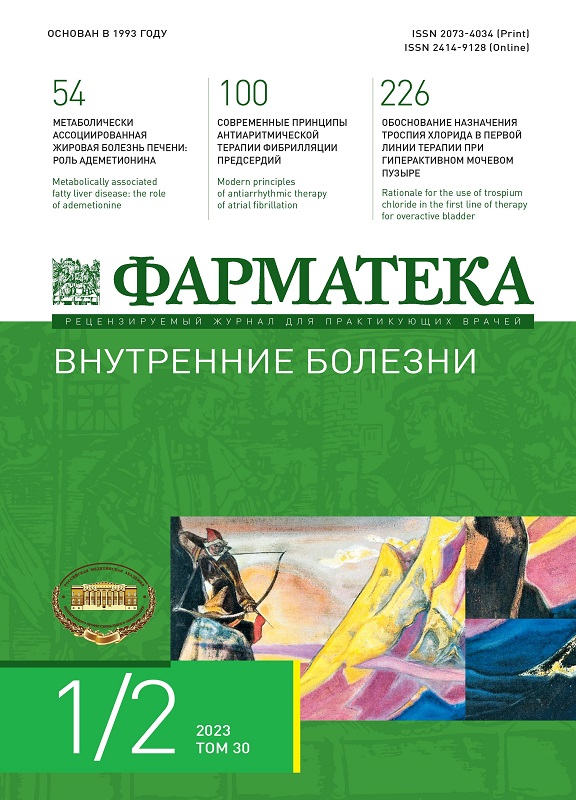Rationale for the use of trospium chloride in the first line of therapy for overactive bladder
- Авторлар: Danilov V.V.1,2, Volnykh I.Y.1
-
Мекемелер:
- Pacific State Medical University
- Far Eastern Federal University
- Шығарылым: Том 30, № 1/2 (2023)
- Беттер: 226-230
- Бөлім: Urology/nephrology
- ##submission.datePublished##: 15.06.2023
- URL: https://journals.eco-vector.com/2073-4034/article/view/463138
- DOI: https://doi.org/10.18565/pharmateca.2023.1-2.226-230
- ID: 463138
Дәйексөз келтіру
Аннотация
The problem of an overactive bladder has been relevant for the last decades. Currently, drugs from the pharmacological group of M-cholinolytics, which increase the functional capacity of the bladder and reduce the severity of the clinical picture of urination disorders, are considered to be the main tool for the treatment. Moreover, M-anticholinergics with the chemical structure of tertiary amines affect the central nervous system. In this regard, trospium chloride, being a water-soluble quaternary base, has significant advantages in diagnosing the functional state of the central nervous system while prescribing treatment.
Толық мәтін
Авторлар туралы
Vadim Danilov
Pacific State Medical University; Far Eastern Federal University
Хат алмасуға жауапты Автор.
Email: Vadim_danilov@list.ru
Dr. Sci. (Med.), Urologist, Professor at the Institute of Surgery, Department of Clinical Pharmacology
Ресей, Vladivostok; VladivostokI. Volnykh
Pacific State Medical University
Email: Vadim_danilov@list.ru
Institute of Surgery
Ресей, VladivostokӘдебиет тізімі
- Abrams P., et al. The Standartisation of Terminology of Lower Urinary Tract Function: Report from the Standartisation Sub-comittee of International Continence Society. Neurourol Urodyn. 2002;21:167–78. doi: 10.1002/nau.10052.
- Chen G., Lin T., Hu S., Chen Y., Lin L. Prevalence and Correlation of Urinary Incontinence and Overactive Bladder in Taiwanese Women. Neurourol Urodyn. 2003;22(2):109–17. Doi: 10.1002/ nau.10010.
- Cardozo L., et al. Efficacy of trospium chloride in patients with detrusor instability; placebo controlled, randomized, double-blind, multicenter clinical trial. BJU Int. 2000;85:659–64. doi: 10.1046/j.1464-410x.2000.00575.x.
- Данилов В.В., Данилов В.В., Данилов В.В. Синдром гиперактивного мочевого пузыря и женские сексуальные дисфункции. Справочник поликлинического врача. 2018;2:53–7. [Danilov V.V., Danilov V.V., Danilov V.V. Overactive bladder syndrome and female sexual dysfunction. Spravochnik poliklinicheskogo vracha. 2018;2:53–7. (In Russ.)].
- Данилов В.В., Лоран О.Б. Диагностика и лечение стрессовой и смешанной форм недержания мочи у женщин. Океанские Вести. 2012. 223 с. [Danilov V.V., Laurent O.B. Diagnosis and treatment of stress and mixed forms of urinary incontinence in women. Ocean News. 2012. 223 p. (In Russ.)].
- Petzinger E., Gavrilova O., Geyer J., Schwantes U. The role of the MDR1 transporter in body distribution and brain penetration of the trospium chloride and oxybutynin. Eur Urol Suppl. 2008;7(3):675. doi: 10.1016/s1569-9056(08)60673-9.
- Данилов В.В., Данилова Т.И., Данилов В.В. Клинико-уродинамическое подтверждение нейрофизиологической модели гиперактивного мочевого пузыря. Урология. 2010;4:15–20. [Danilov V.V., Danilova T.I., Danilov V.V. Clinical and urodynamic confirmation of the neurophysiological model of an overactive bladder. Urologia=Urology. 2010;4:15–20. (In Russ.)].
- Данилов В.В., Данилов В.В. Нейроурология. T. 1. Владивосток, 2019. 280 с. [Danilov V.V., Danilov V.V. Neurourology. T. 1. Vladivostok, 2019. 280 p. (In Russ.)].
Қосымша файлдар








